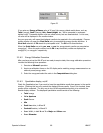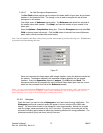3.2.6.4.2 90/10 Knife Edge
This Knife Edge method uses a fixed 90% and 10% of energy as the moving edge Clip%
points. The correction Multiplier is fixed at 1.561. These settings will yield highly accurate
second moment equivalent beam widths for beams that are predominantly TEM
00
in mode
content, and for many other mixed mode combinations. There are a few modes for which
this method will not be as accurate, as well as Top Hat shaped beams. This method will
compute beam widths in the X and Y beam axial directions, or along the computed
orthogonal Major and Minor axes of the beam if the Elliptical calculations are enabled.
3.2.6.4.3 Knife Edge
If your laser mode content is not suitable for measurement using the previous Knife Edge
method, then you can use this method and program your own Clip and Multiplier factors.
For example if your beam is almost a pure donut shape (TEM
01
*), use the previous 90 and
10 Clip% setting, but change the Multiplier to 1.533. For a circular Top Hat, use a
Multiplier of 1.455. For a square Top Hat use a Multiplier of 1.444. This method will
compute beam widths in the X and Y beam axial directions, or along the computed
orthogonal Major and Minor axes of the beam if the Elliptical calculations are enabled.
Hints: In general, your two Clip level settings should add up to 100%. Avoid using clip levels of <10%, as this
begins to approach the camera’s noise floor, especially if your beam peak energy is less than 20% of camera
saturation.
3.2.6.4.4 Percent of Energy
This method will only use a limited amount of your beams energy to compute beam widths.
In particular, it will only use the data from pixels on the X and Y axes of the beam that pass
nearest to the computed centroid. If you have the Elliptical computations enabled, then the
data used for this calculation will be from those pixels that lie along the Major and Minor
axes. The Percent of Energy method requires that you set a Clip % value that
corresponds to the percent of energy that will be used to define the beam width. For
example, set the clip value to 86.47% if your beam is mostly a Gaussian TEM
00
mode. The
resulting beam widths will then be a 1/e², or second moment equivalent value.
3.2.6.4.5 Percent of Peak
This method will only use a limited amount of your beam’s energy to compute beam widths.
In particular, it will only use the data from pixels on the X and Y axes of the beam that pass
nearest to the computed centroid. If you have the Elliptical computations enabled, then the
data used for this calculation will be from those pixels that lie along the Major and Minor
axes. The Percent of Peak method requires that you set a Clip % value that corresponds
to the percent of your beams peak that will be used to define the beam width. For example,
set the clip value to 13.53% if your beam is mostly a Gaussian TEM
00
mode. The resulting
beam widths will then be a 1/e², or second moment equivalent value.
Hint: This method is most useful to measure the widths of Top Hat beams typically based upon a Full-Width-Half-
Max (FWHM) criteria. To achieve this set the Clip% to 50%.
Operator’s Manual LBA-PC
70


















